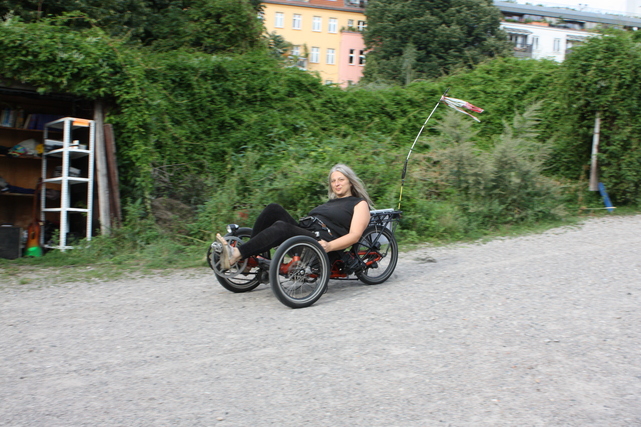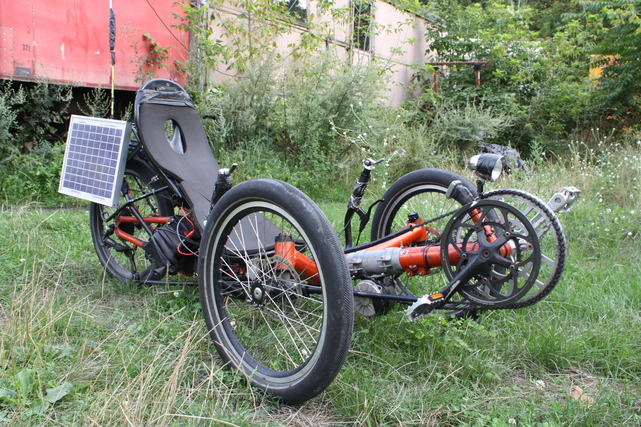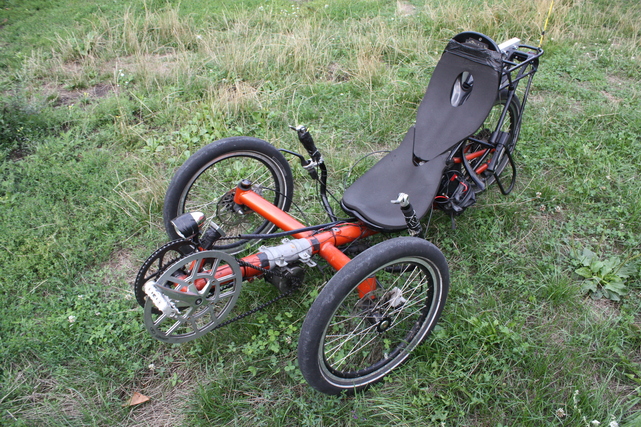I was born and raised in a little village in the black forest, a rangy area in the southwest of former West-Germany. Cycling there can be considered cumbersome if you don't take it as sports challenge, as driving from one village to the next village usually means driving down a few hundred meters in altitude before you go up a few hundred meters again.

When I was eleven or twelve I bought an electric engine in a model craft store - I wanted to build a propulsion unit assisting me to go uphills with my bike. However I didn't have a clever idea how to mechanically propel one of the wheels. So I bought a propeller! I never mounted the engine to the bike because it was obvious from my first test run with the propeller that there wasn't enough drag to have any effect. So it ended up as an unfinished project.

In 1993 I began to work on Pedelecs (Pedal assisted electric cycles) again. Actually the term Pedelec was coined much later. Peter, a friend of mine was a HPV (human powered vehicle) enthusiast, who was into building two-wheel and three-wheel recumbents. One day he had a customer in his workshop, asking him to mount a Bosch electric engine from a Sachs (now named SRAM) "Elektra" (sic!) electric bicycle to his non-recumbent bike. Peter ended up constructing a friction wheel system, with springs pulling the friction wheel to the rear wheel. I took the construction for a test ride - and there was this excitement from childhood again! So I decided to mount a electric engine to my recumbent two-wheel cycle, too.

The Bosch engine had lots of torque but a very unconvincing efficiency of just 60% at best. And it was heavy and expensive. So I started to look for a lightweight engine with high efficiency. I ended up buying an engine in a model craft store again. It had 80% efficiency and 180W at high RPM. The advantage of a moderately sized friction wheel is high RPM, because the surface of the friction wheel rotates at ground speed. So all I needed was a swing arm with the engine on it and a one step reduction gear to the friction wheel. The propulsion unit was quite powerful and the weight was just a few hundred grams without batteries. It was possible to quickly assemble the engine to any kind of bike, and it could recuperate power by breaking with the engine.
However the construction obviously had big disadvantages. First of all friction wheels are not effective. The little friction wheel causes a high amount of fulling of the tyre, causing significant energy losses and tyre wear. Secondly I only had one speed. Many people will tell you that you don't need multiple gears for a electric vehicle, but I assure you this is wrong if you want to build or own a energy-effective vehicle. This is a common misconception in my eyes - most Pedelecs use oversized hub engines, weighting more than 6kg without batteries.
The power of an engine is torque times rotation speed. If the torque isn't sufficient to propel a vehicle uphill at full speed the engine looses its power. If the rated torque is only sufficient to achieve 20% of full speed, the engine can unfold only 20% of its power - as long as the motor current is not increased and the engine overloaded. However the engine current can not be overloaded for an extended amount of time - the engine will overheat and burn. And you can not expect to load the engine with seven times the rated current and consider this to be a reasonable way to deal with the lack of torque. If you exceed a certain amount of current the engine will demagnetize its magnets. Overloading the current will cause severe efficiency losses and wear of the batteries.
So some engineers solve the problem by oversizing the engine. This causes again energy losses. A huge engine is expensive, heavy and it will consume a lot of energy just for rotating on its own at no load. It is not effective to use only 10% or 20% of the power of a huge engine for 90% of the time. Of course one can argue that a oversized engine saves the need for a gearbox and thus saving weight and gear losses, but I don't think this adds up. Oversizing the engines is also a common efficiency problem of cars today.
Realizing this I began to construct a friction wheel drive with a variable automatic gear box, called "Variomatic". The "Variomatic" is a belt drive with V-belt pulleys that automatically vary their effective diameter, depending on RPM. This type of gear is de-facto standard in motor scooters today. However this type of gearbox was too complicated to construct with the humble machines I had available. I bought a Variomatic gearbox but I wasn't happy with the build quality and price. The gearbox had aluminum pulleys with steel balls rotating in it. It was obvious that this solution wouldn't last long. Also the variomatic gearbox would increase the cost and energy losses. So I decided to go and find a different way that would also eradicate the problems of the friction wheel.

One day I finally had an idea which I think is the most simple and effective solution possible that you can build in a DIY way with stock parts and without an expensive lathe or milling machine: Construct a direct gear between the engine and the pedal crank. Just take a pedal arm with sprocket that is usually assembled on the right side of the crank and assemble it on the left side of the crank. Secure the pedal thread with Loctite, as the thread direction was cut for the other side. Find a place where you can mount the engine and fix a sprocket for a bicycle chain on the engine shaft. Put a chain on the sprockets.

The engine will help you pedalling as long as you press a push-button. A pedelec is supposed to be a hybrid - combining electric and human power. Some people dislike this concept, but I think it is a brilliant one. It is cycling with a strong wind pushing from behind. You go up hills with ease and at the speed that a normal cyclist rides on flat ground with no wind. The type of construction makes it mandatory that you pedal with the engine while it is running, so you can not use the engine without pedalling. Which is perfectly conform with the notion of such a hybrid design. Of course you can pedal without the engine. In my construction the engine will always rotate with the pedals, but you'll hardly notice this, at least with the type of engine that I have used. You can add a freewheel if you like. I have been pedalling for long distances without battery power.

Of course you have to be aware of the rotation speeds and gear ratio when constructing such a design. A typical, comfortable pedalling speed is around 80 RPM. It is hard to achieve a reduction gear ratio greater than 9:1 with bicycle sprockets. Either you take a engine with low RPM or one with a reduction gear build-in. On my three-wheel recumbent I have used a Chinese engine without reduction gear, the brand name is "Unite". It is rated at 36 Volts, 17.8 Ampere, 2250 RPM and 500 Watt. I wanted to get rid of an additional reduction gear and I consider 500 Watt to be quite overpowered for a bicycle. Hence I power the engine with only 12 Volts. This has another advantage: Driving with higher battery voltage requires to operate many individual cells in series. This often leads to charge/discharge problems in individual cells of the battery, as all cells are never equal. So over time one needs to perform cell equalization charges and careful cell monitoring. With just 6 lead acid elements in one closed block this problem is unlikely to occur.

An average untrained cyclist can pedal 70 Watt (sustained pedalling on a tour), a trained cycle hobbyist can pedal 120 Watt, while a doped-to-eternity race cyclist can pedal more than 300 Watt. Now take into account that your muscle power will be added to the power of the engine. 220 Watt is not bad for a untrained cyclist. With a 250 Watt engine this adds up to 320 Watt if you are untrained. Being a trained hobbyist the doped race driver is likely to see the backlights of your bike. Still he will beat you if it comes to a short sprint.
If you want the cows to fly at low altitude you want more power, of course. Buy a engine with build-in reduction gear, or construct one (I'd recommend a tooth belt gear as you don't need to mess around with oil or fat and the efficiency is excellent). It would also be interesting to replace the sprockets and chain with a toothed belt drive.
The efficiency of a straight, direct and well lubricated chain-drive is around 98%, so the losses are really neglectable. Thus the engine adds 150 Watts to my pedalling on my bike.
There is no electronic motor controller in my design - and there is no such thing needed as long as the bike has enough speeds. Because I can design and build effective DC/DC converters or PWM controllers this doesn't mean I have to build them into everything that comes around. A motor controller induces efficiency losses and adds a risk of failure. The construction is optimized for cost, efficiency and simplicity. Anyone with the slightest idea about electricity can repair this. The recumbent that the engine is assembled to has 18 gears. Since I switch the gears accordingly to my biological "motor" this also suits the electric engine, since both are tuned to work together. If you pedal comfortably the engine runs at or below rated current. The engine can also run at overcurrent for a while when you accelerate. Also when you accidently start in a gear that is too high or for quickly climbing up a slope, you can just switch on the engine. If you pedal faster than 84 RPM the engine current and output power is going down and you are thus saving energy. If you pedal very fast (like a race cyclist performing a sprint) you are actually charging the batteries. But this is not the idea behind this construction. However, being assembled to a three-wheeler you can remove the drive chain and produce power while the cycle is parking. (I would add a DC/DC step up converter to charge 12 V batteries at lower RPMs, as pedalling more than 100 RPM is not ergonomic. However the current gear ratio would work perfectly for charging 6 Volt batteries)
The system doesn't necessarily require any electronic circuitry. The propulsion system has a self-resetting polyswitch fuse rated at 18 Ampere (2 x 9 Ampere in parallel) and a powerful electromechanical 12 Volt relay, controlled by a push-button located at the handle-bar. In case someone overloads the engine for an extended amount of time the engine and the self-resetting fuse will heat up and subsequently the fuse will interrupt the power supply. Once it is cooled down it will reset and enable the power again, given that the push-button is released. For end-users not keeping an eye on battery charge state you should add a low-voltage disconnect circuit, to protect the batteries agains damage from deep discharge. However I hardly exceed the range of the cycle in my day-to-day usage. I always recharge the cycle as soon as I come home, so I almost never use the full battery capacity, which is a good recipe to have lead-acid batteries last long, as they don't like deep discharging cycles. In order to charge the battery I connect the bike to my existing solar system at home, or a automatic lead-acid charger for mains power if I want to charge on the go.
I have assembled the engine to a HP Velotechnik Scorpion, a German tadpole three wheel recumbent. The bike has a weight of about 17kg, the propulsion system adds about 11kg. If I pedal easily with the engine switched on the bike accelerates to a speed of 30-32km/h. When speeding I can achieve 38km/h. At 30km/h the range is about 40-45 km. I have been riding 108km in 6 hours and 30 minutes driving time, partly over gravel roads and through loose sand. This is of course far beyond the range of the batteries. At an average speed of 22km/h I could achieve a range of 65km, so I had to pedal 43km without assistence from the engine. Once the Panasonic batteries are worn out, I'm planning to replace them by LiFePo batteries. They have 4 times the energy density and can be charged faster (i.e. within an hour). Typically I have a charge time of 5 hours or less with the Panasonic VRLA batteries. However a 100% discharge cycle will take 8 hours in order to regain 100% capacity. You can charge 90% of the capacity in 5 hours, but in order to achive a complete charge you need three extra hours. The Panasonic VRLA CA series isn't a bad choice for such a vehicle. The batteries have a weight of 3.8kg per battery, so 7.6 kg all together. The engine weights 2.5kg. I haven't put the rest (chain, sprockets, cables, relay, switches, assembly material) on a scale, but it is probably around 1kg.
The material for the engine, charger and batteries can be purchased for less than 500 Euro. Using a engine with build-in reduction gear will significantly reduce the costs, as I have payed a fortune for the large front sprocket and cover.
The system consumes about 800Wh for 100km. Compared to the battery wear the other costs seem to be neglectable. I have yet to find out how long the batteries will last. I can not give a definite answer as this also depends on how you treat them. According to Panasonic the batteries last 500 cycles at 50% depth of discharge - before their capacity breaks down to 60% of the rated value. I'm expecting a range of 8000km before replacing them. I also don't know how long the Chinese engine will last. It is not brushless, so I'll have to replace the brushes from time to time and the collector ring will eventually wear out. Still need to find a source for the brushes. In the worst case I'll buy similar brushes and sandpaper them until they fit.
A few people were suggesting that it might be unsafe to gear the engine directly to the pedals. Well, I think someone must be very stupid to hurt himself with the engine while riding the bike. First of all the engine is quite low power. You can easily stop it with your feet. Second the engine is attempting to propel the bike. It can not accelerate aggressively as long as it has to drive the cycle forward. However you shouldn't switch to a very low gear while you drive at high speed *and* switch the engine on. In this case the engine has nothing to do except rotating your feet. The only effect however is that you will be surprised that your feet are pedalling unwillingly if you do this the first time.
The worst thing that you really shouldn't do is put your fingers between the chain and the sprockets and switch the engine on. Same goes for chainsaws, mixers, any machine with rotating parts. In order to avoid me or someone accidently switching it on while working on it or parking I have a kill-switch under the seat.
There is a European legislation which rules that a Pedelec with less than 250 Watt and speed limit of 25km/h is a bicycle, given that the engine only works when you are pedalling. So you don't need a drivers license, insurance, insurance plate, number plate or helmet. There is also no minimum age to drive such a bike. Some countries have no speed limit for Pedelecs. It would be lovely to have no speed limit. I am perfectly fine with a power limit, and 250 Watt is more than enough for a bike when you use it wisely.
In order to comply with the speed limit regulation I have added a circuit breaker to the front derailleur. The engine only works if you are driving on the small front sprocket.